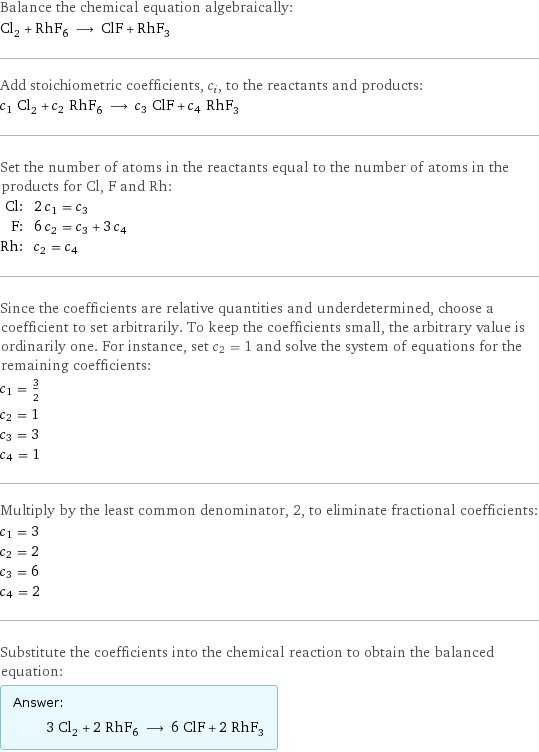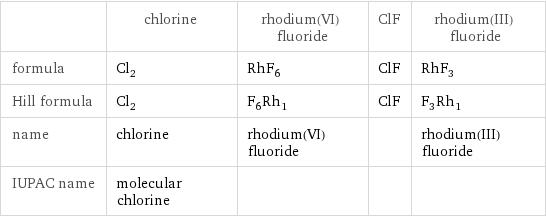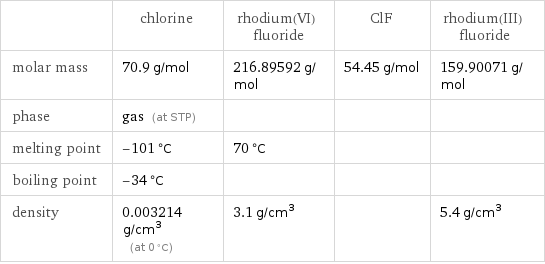Input interpretation

Cl_2 chlorine + RhF_6 rhodium(VI) fluoride ⟶ ClF + RhF_3 rhodium(III) fluoride
Balanced equation

Balance the chemical equation algebraically: Cl_2 + RhF_6 ⟶ ClF + RhF_3 Add stoichiometric coefficients, c_i, to the reactants and products: c_1 Cl_2 + c_2 RhF_6 ⟶ c_3 ClF + c_4 RhF_3 Set the number of atoms in the reactants equal to the number of atoms in the products for Cl, F and Rh: Cl: | 2 c_1 = c_3 F: | 6 c_2 = c_3 + 3 c_4 Rh: | c_2 = c_4 Since the coefficients are relative quantities and underdetermined, choose a coefficient to set arbitrarily. To keep the coefficients small, the arbitrary value is ordinarily one. For instance, set c_2 = 1 and solve the system of equations for the remaining coefficients: c_1 = 3/2 c_2 = 1 c_3 = 3 c_4 = 1 Multiply by the least common denominator, 2, to eliminate fractional coefficients: c_1 = 3 c_2 = 2 c_3 = 6 c_4 = 2 Substitute the coefficients into the chemical reaction to obtain the balanced equation: Answer: | | 3 Cl_2 + 2 RhF_6 ⟶ 6 ClF + 2 RhF_3
Structures

+ ⟶ ClF +
Names

chlorine + rhodium(VI) fluoride ⟶ ClF + rhodium(III) fluoride
Equilibrium constant
![Construct the equilibrium constant, K, expression for: Cl_2 + RhF_6 ⟶ ClF + RhF_3 Plan: • Balance the chemical equation. • Determine the stoichiometric numbers. • Assemble the activity expression for each chemical species. • Use the activity expressions to build the equilibrium constant expression. Write the balanced chemical equation: 3 Cl_2 + 2 RhF_6 ⟶ 6 ClF + 2 RhF_3 Assign stoichiometric numbers, ν_i, using the stoichiometric coefficients, c_i, from the balanced chemical equation in the following manner: ν_i = -c_i for reactants and ν_i = c_i for products: chemical species | c_i | ν_i Cl_2 | 3 | -3 RhF_6 | 2 | -2 ClF | 6 | 6 RhF_3 | 2 | 2 Assemble the activity expressions accounting for the state of matter and ν_i: chemical species | c_i | ν_i | activity expression Cl_2 | 3 | -3 | ([Cl2])^(-3) RhF_6 | 2 | -2 | ([RhF6])^(-2) ClF | 6 | 6 | ([ClF])^6 RhF_3 | 2 | 2 | ([RhF3])^2 The equilibrium constant symbol in the concentration basis is: K_c Mulitply the activity expressions to arrive at the K_c expression: Answer: | | K_c = ([Cl2])^(-3) ([RhF6])^(-2) ([ClF])^6 ([RhF3])^2 = (([ClF])^6 ([RhF3])^2)/(([Cl2])^3 ([RhF6])^2)](../image_source/a4722dbd0a3e6d83101220a2971ed191.png)
Construct the equilibrium constant, K, expression for: Cl_2 + RhF_6 ⟶ ClF + RhF_3 Plan: • Balance the chemical equation. • Determine the stoichiometric numbers. • Assemble the activity expression for each chemical species. • Use the activity expressions to build the equilibrium constant expression. Write the balanced chemical equation: 3 Cl_2 + 2 RhF_6 ⟶ 6 ClF + 2 RhF_3 Assign stoichiometric numbers, ν_i, using the stoichiometric coefficients, c_i, from the balanced chemical equation in the following manner: ν_i = -c_i for reactants and ν_i = c_i for products: chemical species | c_i | ν_i Cl_2 | 3 | -3 RhF_6 | 2 | -2 ClF | 6 | 6 RhF_3 | 2 | 2 Assemble the activity expressions accounting for the state of matter and ν_i: chemical species | c_i | ν_i | activity expression Cl_2 | 3 | -3 | ([Cl2])^(-3) RhF_6 | 2 | -2 | ([RhF6])^(-2) ClF | 6 | 6 | ([ClF])^6 RhF_3 | 2 | 2 | ([RhF3])^2 The equilibrium constant symbol in the concentration basis is: K_c Mulitply the activity expressions to arrive at the K_c expression: Answer: | | K_c = ([Cl2])^(-3) ([RhF6])^(-2) ([ClF])^6 ([RhF3])^2 = (([ClF])^6 ([RhF3])^2)/(([Cl2])^3 ([RhF6])^2)
Rate of reaction
![Construct the rate of reaction expression for: Cl_2 + RhF_6 ⟶ ClF + RhF_3 Plan: • Balance the chemical equation. • Determine the stoichiometric numbers. • Assemble the rate term for each chemical species. • Write the rate of reaction expression. Write the balanced chemical equation: 3 Cl_2 + 2 RhF_6 ⟶ 6 ClF + 2 RhF_3 Assign stoichiometric numbers, ν_i, using the stoichiometric coefficients, c_i, from the balanced chemical equation in the following manner: ν_i = -c_i for reactants and ν_i = c_i for products: chemical species | c_i | ν_i Cl_2 | 3 | -3 RhF_6 | 2 | -2 ClF | 6 | 6 RhF_3 | 2 | 2 The rate term for each chemical species, B_i, is 1/ν_i(Δ[B_i])/(Δt) where [B_i] is the amount concentration and t is time: chemical species | c_i | ν_i | rate term Cl_2 | 3 | -3 | -1/3 (Δ[Cl2])/(Δt) RhF_6 | 2 | -2 | -1/2 (Δ[RhF6])/(Δt) ClF | 6 | 6 | 1/6 (Δ[ClF])/(Δt) RhF_3 | 2 | 2 | 1/2 (Δ[RhF3])/(Δt) (for infinitesimal rate of change, replace Δ with d) Set the rate terms equal to each other to arrive at the rate expression: Answer: | | rate = -1/3 (Δ[Cl2])/(Δt) = -1/2 (Δ[RhF6])/(Δt) = 1/6 (Δ[ClF])/(Δt) = 1/2 (Δ[RhF3])/(Δt) (assuming constant volume and no accumulation of intermediates or side products)](../image_source/cb933bdafb421da4595e04f807873366.png)
Construct the rate of reaction expression for: Cl_2 + RhF_6 ⟶ ClF + RhF_3 Plan: • Balance the chemical equation. • Determine the stoichiometric numbers. • Assemble the rate term for each chemical species. • Write the rate of reaction expression. Write the balanced chemical equation: 3 Cl_2 + 2 RhF_6 ⟶ 6 ClF + 2 RhF_3 Assign stoichiometric numbers, ν_i, using the stoichiometric coefficients, c_i, from the balanced chemical equation in the following manner: ν_i = -c_i for reactants and ν_i = c_i for products: chemical species | c_i | ν_i Cl_2 | 3 | -3 RhF_6 | 2 | -2 ClF | 6 | 6 RhF_3 | 2 | 2 The rate term for each chemical species, B_i, is 1/ν_i(Δ[B_i])/(Δt) where [B_i] is the amount concentration and t is time: chemical species | c_i | ν_i | rate term Cl_2 | 3 | -3 | -1/3 (Δ[Cl2])/(Δt) RhF_6 | 2 | -2 | -1/2 (Δ[RhF6])/(Δt) ClF | 6 | 6 | 1/6 (Δ[ClF])/(Δt) RhF_3 | 2 | 2 | 1/2 (Δ[RhF3])/(Δt) (for infinitesimal rate of change, replace Δ with d) Set the rate terms equal to each other to arrive at the rate expression: Answer: | | rate = -1/3 (Δ[Cl2])/(Δt) = -1/2 (Δ[RhF6])/(Δt) = 1/6 (Δ[ClF])/(Δt) = 1/2 (Δ[RhF3])/(Δt) (assuming constant volume and no accumulation of intermediates or side products)
Chemical names and formulas

| chlorine | rhodium(VI) fluoride | ClF | rhodium(III) fluoride formula | Cl_2 | RhF_6 | ClF | RhF_3 Hill formula | Cl_2 | F_6Rh_1 | ClF | F_3Rh_1 name | chlorine | rhodium(VI) fluoride | | rhodium(III) fluoride IUPAC name | molecular chlorine | | |
Substance properties

| chlorine | rhodium(VI) fluoride | ClF | rhodium(III) fluoride molar mass | 70.9 g/mol | 216.89592 g/mol | 54.45 g/mol | 159.90071 g/mol phase | gas (at STP) | | | melting point | -101 °C | 70 °C | | boiling point | -34 °C | | | density | 0.003214 g/cm^3 (at 0 °C) | 3.1 g/cm^3 | | 5.4 g/cm^3
Units
